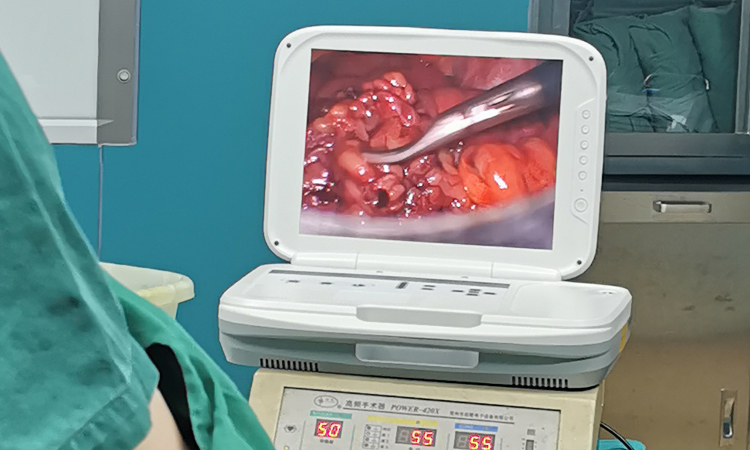Laparoscopic hernia surgery, you know?
First of all, what is hernia surgery?
Hernia surgery, also referred to hernia repair surgery, is the defect by forcing the two ends of the defect together with sutures to repair the operation;
Since the most common surgical hernias are inguinal hernias (mostly caused by weak musculofascia or congenital abdominal wall defects) and wound hernias (caused by abdominal surgical wound infection), the treatment of hernias is mainly surgical. Local or partial anesthesia is used for inguinal hernias, while general anesthesia is used for wound hernias.
Traditional hernia surgery involves making a 4-6cm incision in the inguinal canal, and then placing a patch in the inguinal defect to repair the inguinal hernia.
Laparoscopic hernia surgery is made three puncture hole above the groin area, then free peritoneal, will be free after peritoneal clearance before muscle pubic hole completely free, place the patch on the front of the peritoneal covering the muscle pubic hole completely, at the same time can cover left oblique hernia, hernia and femoral hernia of the inner ring, basically won't recurrence after surgery.
Procedures of laparoscopic hernia surgery:
1. Peritoneal incision:
In the hernia defect, the peritoneum was cut from the medial umbilical fold to the anterior superior iliac crest, and the upper and lower peritoneal flaps were dissociated to enter the preperitoneal space.
There are two points to note:
① the medial side can not exceed the medial umbilical fold, so as not to damage the bladder;
② The subabdominal artery and vein should be avoided when the middle peritoneum is cut open.
All operations are performed behind the transverse fascia without opening the fascia.
2. Treatment of hernia sac:
Any "lipoma" outside the hernia sac should be removed, otherwise the "lipoma" will slip into the inguinal canal and cause a recurrence similar to "extraperitoneal sliding hernia".
Pull the hernial sac from the abdominal wall defect and high back, the abdominal cavity, the hernial sac from the inner ring opening level with the rear of the spermatic cord blood vessels and vas deferens separation for about 5-150 px, this "super" free hernial sac method called "the abdominal wall of spermatic cord", its purpose is to make sure enough patch can tile not curled up on the spermatic cord ingredients.
3. Placement of the patch:
The principle of the mesh repair is to replace the fascia transversalis to cover the entire musculopubic foramen and to overlap with the surrounding muscular and bony tissue.
Specifically, the upper part of the mesh should cover the conjoint tendon 2-75px, the lateral part should reach the anterior superior iliac spine, the medial part should cover the rectus abdominis and the pubic tubercle and exceed the midline, and the lower medial part should be inserted into the pubic bladder space instead of directly covering the bladder.
4. Closure of peritoneum:
Absorbable sutures and hernia pins can be used to close the peritoneum.
Peritoneal closure must be close to avoid postoperative intestinal adhesion.
5. Postoperative treatment:
After laparoscopic hernia surgery, fluid or semi-fluid diet could be resumed 6 hours after surgery, and general diet could be resumed 24 hours after surgery.
On the second day after surgery, the patient was able to move and go home, and was able to return to normal exercise one week after surgery.
The advantages of laparoscopic hernia surgery:
1. more minimally invasive: the traditional surgical incision is about 1-2cm, laparoscopic surgery although there are two to three incisions, but the largest hole is also 5mm, after healing, basically can not see the scar, and the operation does not need to dissection the inguinal canal, the structure of the tissue damage is small, so the damage under the incision is smaller.
And the size of laparoscopic incision is not restricted by obesity and other physical conditions.
2. Laparoscopy can find lesions on the opposite side: many unilateral hernias are actually bilateral, but before laparoscopic surgery, some children open one side, after a period of time, the other side of the hernias appear, and need to do a second operation.
After in laparoscopic surgery, found that many children from unilateral hernia is double side, the other side just because the gap small intestines fall out at that time, can't find them, not when it only need to put the mirror in the laparoscopic surgery can be clear to check on both sides, found the contralateral has only need to add a 2 mm pinhole bilateral operation can be completed.
3. operation effect more reliable: a hernia operation point is as far as possible in the high ligation of hernia sac, laparoscopic surgery in abdominal cavity operation, can clearly exposed inguinal inner ring of the mouth (that is, the top of the hernial sac), and it is in the perspective of the zoom operation, after ligation can clear check the effect of ligation, so operation effect is exact.
4. surgery safer: laparoscopic surgery because the anatomy of the less, and it is in the perspective of amplification of the surgery, so I can clearly show vas deferens, spermatic veins, surgery time simply slide with blunt sled needle, so almost no vice damage, so the traditional surgery postoperative scrotum hematoma, edema in laparoscopic surgery opportunity will not encounter such issues.
And the operation takes less time, about five minutes for a skilled doctor.
